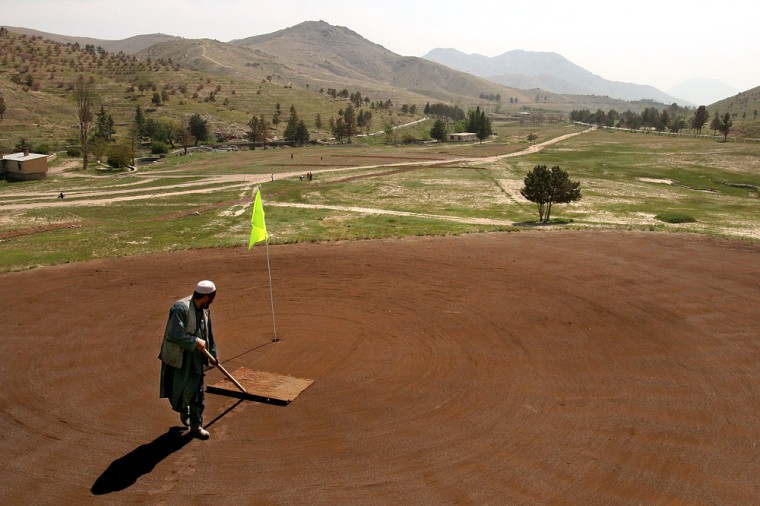I am not a golfer, but that hardly stopped me from having a memorable day at the Kabul Golf Club. You see, the Kabul Golf Club is only barely a golf course.
Its fairways have only recently been cleared of land mines, its “greens” are made of dirt for lack of grass, and two busy roads run through it, filled with horn-tooting young Afghans returning from day trips out of the capital.
Despite these shortcomings, nobody can accuse the club of false advertising when it boasts on the score sheet handed out to players that it is without a doubt the “best, and only” course of its kind in Afghanistan.
The message seems to be catching on.
Out of reach for average Afghan
Since it opened last year, the club has picked up about 60 regular customers, most of them foreigners, said Muhammad Afzal Abdul, the course manager.
A round on the nine-hole course costs $15, with an extra $5 charge for mandatory caddie service.
That’s a lot in a country where most people get by on a few dollars a day. But for many expatriates, it’s a small price to pay for a round of golf on one of the most unlikely courses in the world.
Even for a terrible golfer like myself, it was a thrill to tee off in the shadow of the snowcapped Hindu Kush mountains, in a country where most of my job involves reporting on the aftermath of war.
Mud holes and mounts of dirt
Teeing off with a group of colleagues, my first shot kicked off to the right, landing in a foot-deep mud hole about 30 yards from the tee.
“No problem,” said my caddie, Mohammed Karim, picking the ball up and putting it on a fresh tee. As I would soon learn, club rules allow golfers to tee their ball up after nearly every shot, since nearly every ball finds its way into a rocky crag, a deep muddy hole, or an impossibly steep mound of dirt.
Putting isn’t much easier. The black sand on the putting “greens” is quickly spoiled by the footprints of other golfers, and it is exceedingly hard to get a read on how the ball will roll. It’s a bit like golfing in a children’s sandbox.
I took a quintuple-bogey nine on the 371-yard, par-4 first hole, and an eight on hole no. 2. After that I lost count, and just had fun.
Even if the course is rough by Western standards, its condition still represents a stunning reversal of fortune.
Under Taliban, golf was a sin
The club was all but abandoned after the Soviets invaded Afghanistan in 1979, when most Western embassies evacuated their staff. During the civil war of the 1990s, warlords lobbed mortars and rockets across the fairways, destroying the clubhouse.
When the hard-line Taliban militia came to power in 1998, it declared golf un-Islamic and shuttered the course, or what was left of it.
Club employees suffered even more.
“The Taliban came to my home one night and took me away,” said Abdul, the club pro and Afghanistan’s former golf champion. “They brought me to the intelligence service building and beat me every night with cables. They told me golf was a sin and accused me of being at the service of foreigners.”
'Reunited with my golf'
Abdul said that when he got out he found that his infant son had died because his wife was so malnourished she couldn’t produce enough breast milk to feed him.
Like millions of his countrymen, Abdul fled to Pakistan, getting a job as a taxi driver in the northwestern frontier city of Peshawar.
When he heard that the club was to reopen, he came back home. He says he sees the future of both the course, and his country, as bright.
“I am very happy now,” he said as we walked serenely through the dried-up bed of what was once the club’s only water hazard. “We have peace and security in Afghanistan now, and I have been reunited with my golf. It had been way too long since I picked up a club.”
